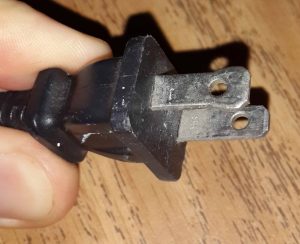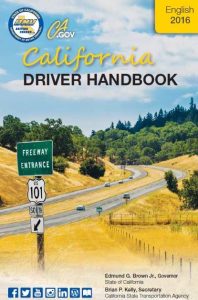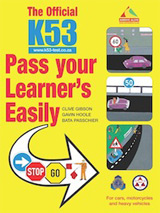We’ve been in the US for quite a while now. And there’s so much I’ve wanted to write about, but a new article for each one seemed extreme. So after being a draft for about three months, I’ve finally been able to put together this mega-post on all the random things that pop into my head.
Take note that I am making direct comparisons to my experiences in California, and living in South Africa. California is not the US. Also these are not all bad, they’re just observations, some of them are even good. And in no particular order, they are:
Twisty light switches
I have an odd hate for these. All your bedside and desktop lamps have these twisty knobs on them to turn on and off. Why not a switch. I like switches. I know what to do with switches. And to turn these switches on or off, you turn it in the same direction. Surely it would make more sense to turn it on one way, and turn it off the other way? But no, turning it the other way does nothing.
Shower controls
To date, I’ve found shower controls around the world fairly standard. You have some control over how much hot water, and how much cold water you get. Not in the US. In the US you get X amount of water, and are only allowed to decide how hot or cold it is. So there’s no having a nice hot blast of water, or just dripping a little out. You get X. Come on man, where are we living?!
Smoke alarms
They’re everywhere, we have three in our house (and have only set one off, we’re not sure how)! The only rooms not covered are the bathrooms. I’m not sure of the exact reason why they’re so smoke-alarm happy, but it probably has something to do with all the very flammable gas being piped everywhere, and the heavy presence of wood in their buildings. The smoke alarms also detect carbon-monoxide.
But they’re seriously loud. I nearly had a heart-attack when our one went off by itself. I put earplugs in just to test the one in the above video. And we have three different ones. I was quite impressed to see that our Kidde Smoke Alarm talks to us.
The Coleman gas canister

Electric plugs
I’m iffy on these. They’re different, but I guess not bad per se. What I don’t like is their live and neutral pins are different sizes. Why?! Many small things like chargers are built the same size to avoid annoyance, but our lamps for instance only go in one way! Come on man!
Class action lawsuits
These come in the post, they’re advertised to you on billboards, on the radio, on TV. Everywhere. Law firm sues big company on behalf of 100 plaintiffs, then once a verdict is given, they are allowed to go find more people who may have been affected, and bring them in as part of the case. Law firm obviously gets a bigger settlement from it, and it’s right that people are properly remunerated if they are wronged, but often we’re talking about $10 or $20 per plaintiff. For example (source):
Consumers who received automated or pre-recorded call or text on their cell phones from Wells Fargo regarding overdrafts on a Wells Fargo account between April 21, 2011 and December 19, 2015 may be eligible for a pro rata share of the $30 million settlement. The company reached a settlement over allegations of violations of the Telephone Consumer Protection Act.
Do I really deserve money because Wells Fargo phoned me. Sure punish them. But yeah.
Marketing
Marketing in general is huge. I regularly see planes flying overhead with banners advertising something. Billboards, benchboards, bus stop adverts are all updated with regularity, showing the latest movies and TV series. Adverts also regularly feature prominent movie and TV personalities.
Online, my twitter feed receives far more adverts than it once did. I assume just because less people are paying for adverts aimed towards people with location South Africa, than Los Angeles. I’ve also been doing a lot of writing, and researching online products. As such I’ve had to start using Incognito mode more, otherwise my Facebook, Twitter and YouTube just fill up with adverts for the products I’ve recently been browsing on Amazon
Then there are also the pharmaceutical adverts, they’re mainly restricted to TV (which we don’t have), but they are still odd to watch, where adverts for all kinds of drugs are placed, encouraging you to discuss these products with your GP.
Cellphone contracts
Prepaid packages are rare. Most of the big companies don’t offer a traditional prepaid package where you load $20 and pay per SMS and phonecall. Instead you sign up for a monthly contract, and just pay in advance. But that package is by default unlimited local phone calls and SMSs. It’s no wonder no one uses WhatsApp. Why would they when they can just SMS indiscriminately. The rate is also fairly flat between providers since porting gained public attention. Only price differences come in when selecting how much data you want. Discounts are also offered for family packages.
Also every, single, freaking, provider locks their phones to their network.
Internet
It’s wonderful. It’s fast. At home our flat came with included Wi-Fi, and although I’d like an ethernet cable, I’m not complaining:

Halloween & Thanksgiving
Halloween was fun. Everyone dresses up. Everyone. Even on campus during the days around Halloween people were dressed up. The 7-11s put up signs requesting people to remove their masks when entering the premises.
It was fun. People put a lot of effort into their costumes, have parties, and generally just have a good time. Trick or treating is apparently also still big, in the more residential neighbourhoods. Also pumpkin carving. That was fun. Thanksgiving was fun too. A few weeks after Halloween, things kind of just flow from one to the next. It’s a great friends and family holiday, full of traditional food, like mac ‘n cheese. And more traditional food like Turkey and Pumpkin Pie. And while people don’t dress-up for this one, marketers go crazy, and you get all the pumpkin flavoured coffees, beers and other paraphernalia emerging.
Thanksgiving was fun too. A few weeks after Halloween, things kind of just flow from one to the next. It’s a great friends and family holiday, full of traditional food, like mac ‘n cheese. And more traditional food like Turkey and Pumpkin Pie. And while people don’t dress-up for this one, marketers go crazy, and you get all the pumpkin flavoured coffees, beers and other paraphernalia emerging.
Live shows!
LA is great for this. There’s always something happening. And every time there’s a show on at one of the big venues (which is most of the time), it’s a band you know or recognise. Those odd bands and comedians you knew back home, who would never tour to SA, they tour to LA. Or they live in LA.
Now all we need is some more money to go to more events.
Helicopters
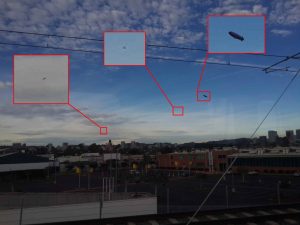
Normal day in LA. Two helicopters and the Good Year blimp. My eyesight is way better than my phone’s camera.
They’re everywhere. This is partially LA specific. At any single time, there are at least two police helicopters hovering over LA, ignoring news and personal helicopters. It’s the police helicopters that tend to fly lower and hover. While you’re trying to sleep. I think it’s started to blend into the background noise of the city, but every now and then I notice it and get annoyed.
ITAR
The American government doesn’t trust foreigners. Especially when it comes to anything semi-related to rockets, which includes the entire aviation field. As such if you’re not a US citizen you require a special ITAR clearance to work in the aviation, military, or space industry. This is a lot of extra work for a company, and many couldn’t be bothered. As such I’ve been greeted with many a job application, that on the first line, lists as a requirement, that you are a US citizen. This has nothing to do with work eligibility.
Petrol
Firstly their octane ratings are all wrong (more about that here). Secondly they sell at least three different octane ratings at every gas station. Thirdly they call petrol gas (-oline), when clearly it’s a liquid. Fourthly diesel is hard to come by within a city, like many gas stations don’t sell it. Fifthly fuel prices can differ by over a dollar per gallon within the same city. Sixthly you have to pump your own gas (I actually really enjoy this. It’s great)
Driving
Driving is fine. People in LA tend to drive fast and in a rush (compared to CT and EL). It’s not a problem (not like them driving on the wrong side of the road). However, the law states that you are allowed to pass a vehicle that is in the fast lane, by driving in one of the slower lanes (pg38 2016 CA driver handbook). They do advise that if you are in the fast lane and being passed, you should move to a slower line, the phrasing being (pg65 2016 CA driver handbook):
the best thing to do is move into the right lane, when it is safe, and let the vehicle(s) pass.
That is an advisement. Not a law. There is a new law that says in a single lane road, a vehicle must turn out if a line of 5 or more vehicles forms behind them. As they don’t make use of the ‘yellow-lane’ to allow overtaking.
But basically a lot of drivers drive slowly in the fast lane which results in people in a hurry weaving through the 5 lane traffic, in and out, and people flying past on your right, because they don’t want to wait for the slow driver in front to pull over. This is contrary to many other countries where it is a law to get out of the way of faster moving traffic.
They have got the Right on Red thing going for them, which is great, and should be made law in SA as well. If you’re turning at a traffic light, and do not need to cross moving traffic to do so, you are allowed to turn against a red light, if safe to do so.
You can read more about this here, as I just got my CA licence.
Popcorn
You know like at the movies? They soak them in butter. Icky, oily, butter. I guess it tastes nicer, but now my hands are covered in greasy oil. Also, no salt shakers. Apparently that’s not how it’s done. They offer tiny little salt sachets, but you have to open like 5 or more to get any kind of taste. No other flavours either really. Just butter.
Self-Checkout Terminals
Yes, yes, yes. Saving me so much time (and some awkwardness). There’s always an open terminal at the self-checkout aisle in the grocery stores. They’re wonderful. I don’t have to stand in queues. Don’t have to interact with the admittedly very nice cashiers. I can just do my thing and be on my way.
Apparently PnP in Ottery are running a trial with these. Last I heard it wasn’t going too well.
Money
 I’ve never been a fan of cash, not at home, not anywhere. But the Americans confuse it all by making all their notes look almost identical. That is, similar size and same colour. When you do find ones that are different colours, they’re just different prints of the same note. And don’t get me started on their coins. Although I like quarters. They’re pretty cool as far as coins go.
I’ve never been a fan of cash, not at home, not anywhere. But the Americans confuse it all by making all their notes look almost identical. That is, similar size and same colour. When you do find ones that are different colours, they’re just different prints of the same note. And don’t get me started on their coins. Although I like quarters. They’re pretty cool as far as coins go.
Then Credit-Cards. You want to pay with a CC at a restaurant. They bring you the bill, and tell them you want to pay by card. They take the bill and your card away from you, then come back later, return your card to you, and you leave you with a slip on which to write the tip. Then once you’ve left, with your card, they go back to the terminal and add the tip into the final amount that gets debited. This is normal. This is standard.
And don’t get me started on EFTs. Such a thing does not exist. If I owe my friend John $20, I either have to give it to him in cash, or write him a cheque. Or use one of many online, non-bank affiliated services to send him money (such as PayPal). I can do a wire. But, the bank will usually charge me $10 per wire. Many companies will at least pay employees by Direct Deposit, which at least avoids any fees, but this seems to not be in the domain of the average Joe. Or John. Or John’s friend who just wants to pay him.
Buying Alcohol
The drinking age in the US is 21. This is not a problem as I am 27. What is a problem is that everyone asks for ID. Everyone. Buying wine from your local supermarket. ID. Going into a bar. ID. Sitting in a restaurant. ID (well they’re a little more slack). So this is not a problem in and of itself. What is a problem is that they don’t like SA driver’s licences, or even our fancy new ID cards. No. If you don’t have a US government issued ID, you need to show them a passport. Which means I have to carry my passport around with me everywhere. Which I don’t like doing, and its big and bulky, especially if you’re heading out to for the night. I also often forget it at home, and then am left unable to purchase alcohol.
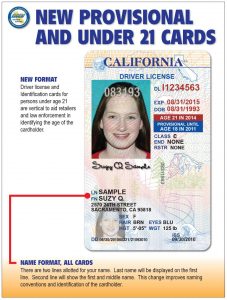 This was only part of the motivation to get a CA driver’s licence. Some licences even state the year the person turns 21 to save the bouncer some effort.
This was only part of the motivation to get a CA driver’s licence. Some licences even state the year the person turns 21 to save the bouncer some effort.
End
That’s all I can think of at the moment. I won’t even get started on the politics. I added an extra five points to this yesterday, so feel it’s time to stop. I’m sure I’ll start another article and build it up over the next few months for a part 2.
But in between all the complaints, and differences, it’s very similar to home. We haven’t experienced in kind of culture shock, and are enjoying ourselves in the very fair LA.

